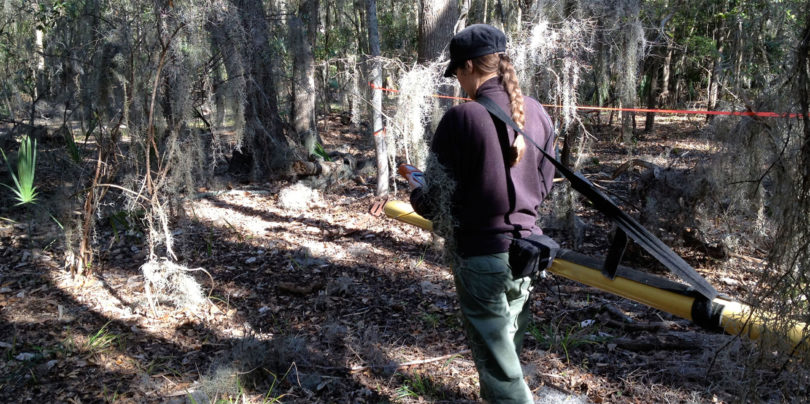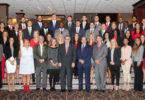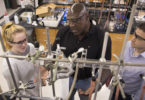 Tommy Jordan, left, associate director of the UGA Center for Geospatial Research, and Sarah Ross, right, director of the Wormsloe Institute for Environmental History, pose with Esri founder Jack Dangermond after receiving the Esri Special Achievement in GIS Award.
Tommy Jordan, left, associate director of the UGA Center for Geospatial Research, and Sarah Ross, right, director of the Wormsloe Institute for Environmental History, pose with Esri founder Jack Dangermond after receiving the Esri Special Achievement in GIS Award.
Spanish moss sways slowly in the humid breeze on an average day at Wormsloe. Sarah Ross spends most of her working hours amidst this mix of the live oaks, scrub brush and sandy soil. In an area on the Isle of Hope almost preserved in time, she and others from the University of Georgia conduct research using technology that’s breaking ground and winning international awards.
This year, the Wormsloe Institute for Environmental History, which Ross directs, were chosen for the Esri Special Achievement in GIS Award from among over 100,000 international organizations. Esri, founded by Jack Dangermond in 1969, is an international supplier of Geographic Information System software, web GIS and geodatabase management applications.
Recipients of the Special Achievement in GIS award are submitted by Esri staff, then personally reviewed and selected by Dangermond, according to the Esri website. Winners are chosen for their efforts in embracing GIS technology, using GIS to improve the world and setting new precedents throughout the GIS community.
The UGA Center for Geospatial Research was honored with the award in 2009.
 Holly Campbell, a Wormsloe Fellow and master’s student in soil science, takes soil samples. Photo by Ervan Garrison/UGA
Holly Campbell, a Wormsloe Fellow and master’s student in soil science, takes soil samples. Photo by Ervan Garrison/UGA
Wormsloe was established in 1736 by Noble Jones, one of the original founders of the Colony of Georgia, as a farm and fortification against potential invasion by the Spanish. It has remained under the ownership and management of his descendants ever since. Wormsloe, although inhabited for centuries, has never been developed, making it one of the most ecologically intact properties in the area.
The current owners, ninth generation Jones descendant Craig Barrow and his wife, Diana, created the Wormsloe Institute for Environmental History with Ross, the WIEH director and president, and the Wormsloe Foundation in 2007. In 2013, they donated 15 acres to UGA to create the UGA Center for Research and Education at Wormsloe. Research is conducted on those 15 acres as well as the almost 1,200 that surround them, which are owned by the Georgia Department of Natural Resources.
 Campbell works with her major professor, Larry Morris, on a soil sample. Photo by Ervan Garrison/UGA
Campbell works with her major professor, Larry Morris, on a soil sample. Photo by Ervan Garrison/UGA
In addition to standing in the spotlight to receive the Esri award, Ross also presented and displayed Wormsloe’s research at the annual conference.
“They asked me to give a 45-minute presentation,” Ross said. “About 17,000 people attend this international conference, and it’s most people I’ve ever seen in one place.”
She and other UGA faculty and graduate students, known as Wormsloe Fellows, are building the inventory of the cultural landscape features as a computer-based GIS and are being assisted in the effort by the Center for Geospatial Research and the College of Environment and Design’s Cultural Landscape Laboratory. This GIS inventory will guide future land management plans, research and site interpretation.
“My talk was focused on research we are doing at Wormsloe and the integration of research among various disciplines,” Ross said. “Dr. Tommy Jordan in CGR addressed his site mapping and LiDAR research onsite. At Wormsloe we provide an opportunity for interdisciplinary teamwork and research. We usually have seven Wormsloe Fellows on site conducting research, and the Wormsloe Foundation supports their four-to-five years of study.
“Working side-by-side on their research projects onsite, the Wormsloe Fellows form a bond, which is remarkable, and they start to rely on each other for critical input. The students are so supportive of each other. It’s been just a true model of collegiality.”
The UGA students and professors who conduct at Wormsloe come from various disciplines-including geography, environment and design, archeology, anthropology, history, forestry and ecology-and from various parts of UGA-the College of Environment and Design, Franklin College of Arts and Sciences, Odum School of Ecology and Warnell School of Forestry and Natural Resources.
The projects they’re working on range from solar to water to the intercostal waterway to rice cultivation to augmented reality.
Ross is especially appreciative of the attention Wormsloe has received from state leaders in Atlanta-including Hank Huckaby, chancellor of the Board of Regents of the University System of Georgia, and, most recently, Gov. Nathan Deal.
“The governor came down with his wife and grandchildren and walked the whole site,” she said. “It was very long, casual visit. We just felt so grateful.”
For more information on the Wormsloe Institute for Environmental History, visit www.wormsloeinstitute.org.








